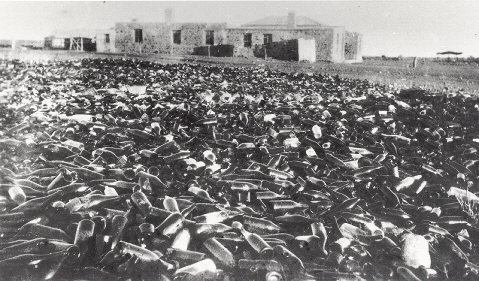
Many thanks to Mortlock Library of South Australia, North Tce, Adelaide, for their permission to publish the photograph.
SLSA:MLSA:B61956
In the early days there was considerable sly grog selling, cattle rustlers, and other dishonest elements, and there was occasional friction between Aborigines and station people. A police camp was established in the area and manned by several mounted constables. The area is subject to flooding from creeks gathering water from hundreds of miles away in Queensland. All the smaller creeks feed the larger Cooper Creek which flows through Innamincka. This beautiful but harsh country gives no foolish man a second chance. Many white people have perished of sunstroke, whilst many others have drowned in the nearby Cooper Creek during times of severe flooding.
The Innamincka Hotel came into existence sometime around the 1870s. The hotel became legendary for it's dump of empty bottles over 180 metres long. The old hotel now in ruin ceased trading in 1952. In 1974, the Cooper Creek was in flood, water rose to the level of the old hotel roof. Sadly the legendary dump which started to grow in the 1870s, was washed downstream for one hundred miles or more. The Cooper Creek contains yabbies, yellowbelly, bream and catfish. The settlement also obtained fame due to the location of the John Flynn Flying Doctor Service Mission established there.